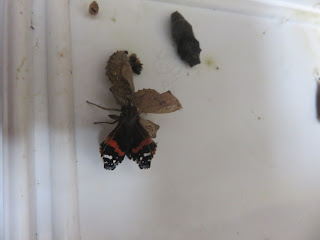The Magic of Butterflies and Moths is my new book
The Magic of Butterflies and Moths is my latest book published by Moon Books. It will be available on 24 February 2023, but it can be preordered now. As the title suggests I take a look at what can be considered as magical about these amazing insects. Everyone is familiar with the incredible transformation from egg to caterpillar to chrysalis and then to adult butterfly but there are many more astounding facts about butterflies and moths.
Swallowtail caterpillars
I first became fascinated by these insects when I was a little boy. I used to keep caterpillars in jam jars and other containers. I learned then that you had to feed the larvae with the right types of plants. I also learned that some chrysalises and pupae have a short time before they emerge as adults, while others must wait many months and go right through the winter and the spring months before eclosing in early summer. Many species of butterfly and moth embark on lengthy migrations at specific times of the year. They can fly incredibly long distances and cross seas. The Monarch is probably most famous of all for its annual migration from the lower part of Canada and the most northerly American states right down to Florida, California and Mexico. It overwinters in the south and in the spring it begins the migration northwards.
Monarch butterfly
I take a look at butterflies that live in the most inhospitable areas where you would probably think these insects cannot be found. But there are butterflies that live within the Arctic circle, in Lapland and Siberia. Some butterflies have extraordinary life cycles. There are species of Blue butterfly that depend on specific species of ants finding their caterpillars. The ants take the caterpillars into their nests where when fully grown the butterfly larvae become chrysalises. The very rare Large Blue is a species that is like this.
Many species of butterfly and moth employ elaborate camouflage as adults and as caterpillars to help protect them from predators. When their wings are folded some species look like dead leaves as adults, some caterpillars look like twigs. Other types have displays and warning colours of bold contrasting hues that are a signal that says “do not eat me because I will poison you!” There are moth species that cannot feed as adults, there are many others in which the females are not only unable to eat but they cannot fly either. Yet the caterpillars of these species are some of the most gaudy and exotic looking of all. Some moths, such as the weird looking Death’s-head Hawk-moth have become the subject of superstitions. Because it has an odd skull-like marking on its thorax and because it has weird behaviour such as the ability to squeak, this moth was regarded as a bad omen.
Death's-head Hawkmoth
As well as the appearances and behaviour of many species of butterfly and moth I take a look at what we can do to help them. There is a chapter devoted to butterfly gardening, as well as a list of some organisations where you can find out more about butterfly (and moth) conservation.
The Magic of Butterflies and Moths has some wonderful endorsements from people such as Rebecca of Rebecca’s Butterfly Farm who said: “Lovely stories and lots of amazing facts.” Paul Hetherington, Buglife Director of Fundraising and Communications described my book like this: “The Magic of Butterflies and Moths is just what is needed to help people understand and have friendlier relationships with these incredible insects, a major goal of our No Insectinction campaign.”
My book will be available from Amazon.com and Amazon.co.uk as well as many other book suppliers around the world. Just Google “Steve Andrews The Magic of Butterflies and Moths” and pick up your copy.
















































